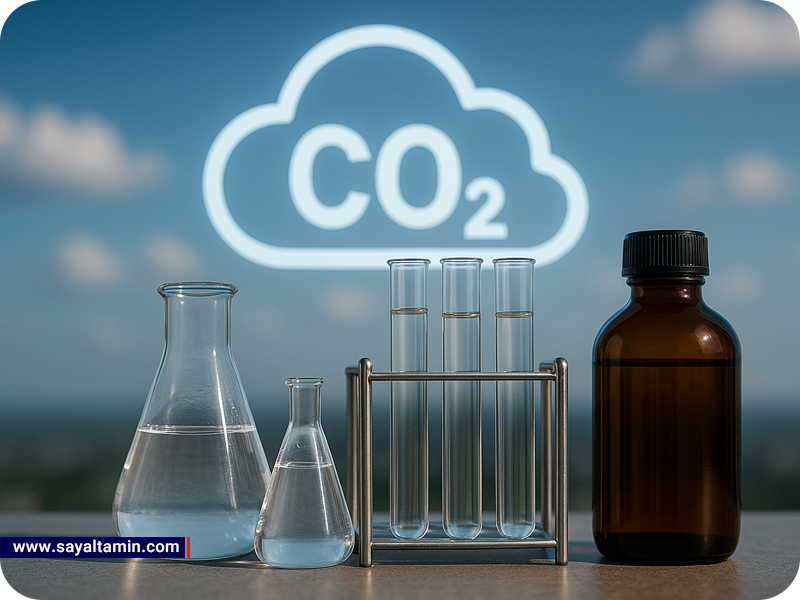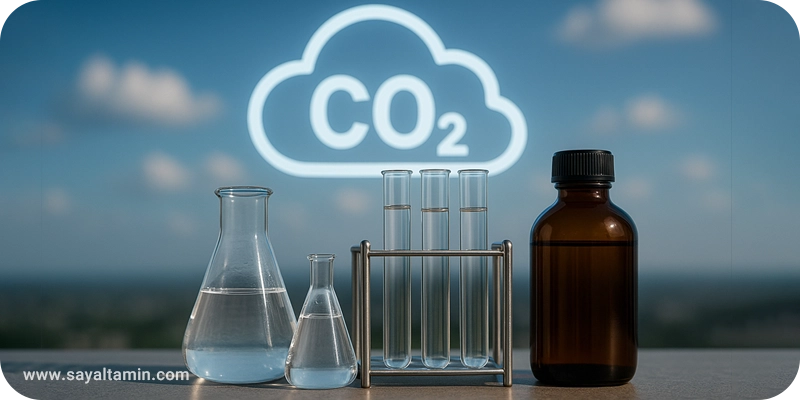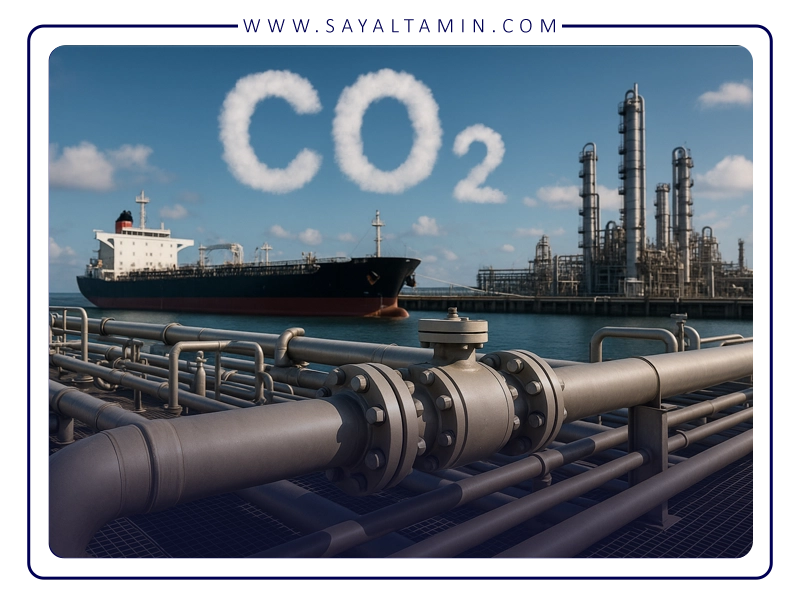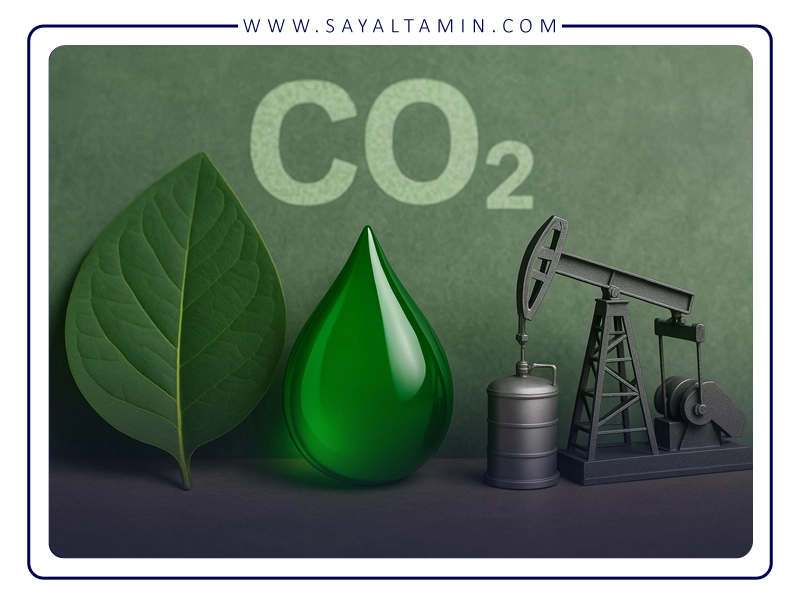This post is also available in: Persian
In recent decades, environmental concerns and strict regulations on reducing pollutants and the use of harmful chemical solvents have driven various industries towards more sustainable and cleaner technologies. Carbon dioxide (CO2), better known as a greenhouse gas, has entered the field of materials science and chemical processes as a green, sustainable and cost-effective solvent in various industries, including oil and gas, pharmaceuticals, food and coatings.
In this article, we review the unique properties of CO2, especially in the supercritical fluid state (scCO2), its important applications in gas condensate processing and other related industries, its technical advantages and challenges, and analyze the future prospects for the use of this technology.
Properties of carbon dioxide as a solvent
Carbon dioxide is a non-polar, non-toxic, and abundant molecule that can be obtained from a variety of sources, including associated gases from gas condensate extraction, industrial processes, or even natural sources. The critical point of CO2 is at 31.1°C and 7.38 MPa, at which point CO2 becomes a supercritical fluid.
This particular state has physical properties between a gas and a liquid, including high solubility, good permeability, tunable density, and low viscosity. These properties allow for the selective extraction and processing of complex compounds, making CO2 an ideal alternative to traditional and toxic organic solvents.
Industrial applications of carbon dioxide in the supply of gas condensate and related industries
1. Extraction and separation of gas condensate
In the oil and gas industry, gas condensates, which consist of light hydrocarbons and liquids dissolved in natural gas, are of great importance. CO2 as a supercritical solvent can be used in the extraction, separation and refining processes of these compounds.
The main advantage here is the elimination of the use of harmful petroleum solvents, which not only reduces the risk of fire and environmental pollution, but also results in higher quality end products without solvent residues. The use of scCO2 in condensate refining reduces process costs and increases extraction efficiency.
2. Recovery and purification of additives and valuable compounds
In the production and optimization of condensates, some valuable compounds such as anti-corrosion additives or active ingredients in refineries require precise separation. As a solvent with adjustable process conditions, supercritical CO2 can recover these materials in high purity without damaging their chemical structure.
3. Application in processing and modification of by-products
Condensate processing typically produces by-products such as oils and fatty acids that require refinement and purification. Due to its high permeability, scCO2 can be used to extract natural oils and process by-products, replacing toxic chemical solvents.
4. Cleaning equipment and transmission lines
In the oil and gas industry, cleaning equipment and pipelines from oil deposits and contaminants is a key maintenance step. Using scCO2 to wash and degrease this equipment is a clean and low-cost method that outperforms traditional methods due to its high penetration capability.

Other uses of CO2 in related industries
1. Pharmaceutical industry
In the pharmaceutical industry, extraction of active compounds from natural sources and controlled drug formulation are carried out via scCO2. This method eliminates toxic solvents and improves the safety of pharmaceutical products.
2. Food industry
In food processing, using supercritical CO2 to extract aromatics, flavors, and decaffeination from coffee is a clean, chemical-residue-free method that increases product quality.
3. Polymer and Coatings Industry
In the production of biocompatible polymers and durable coatings, CO2 is used as a solvent and reaction medium. This leads to a reduction in the use of hazardous solvents and increased safety in production lines.
| Read more: Liquid ammonia in food industry refrigeration systems |
Advantages of using CO2 as a green solvent in gas condensate industries
• Environmental compatibility: CO2 is a natural gas that, by recycling and reusing, can create a closed and sustainable cycle and reduce pollutant emissions.
• High efficiency and tunability: By changing pressure and temperature, the solubility and physical properties of CO2 can be adjusted to suit specific process needs.
• Easy post-process removal: After the extraction or reaction is complete, CO2 is removed as a gas by reducing the pressure, eliminating the need for complex solvent residue separation processes.
• High operational safety: CO2 is non-flammable and low-hazard, which increases the safety of personnel and equipment.
• Reduce environmental costs: Eliminating or reducing the use of toxic solvents reduces waste management and environmental remediation costs.

Technical challenges and obstacles
• Limited solubility of some compounds: Some materials do not dissolve well in CO2, requiring the development of additives or solvents.
• High investment costs: High-pressure equipment and supercritical fluid technologies have high initial costs, which limits widespread adoption.
• Need for advanced technical knowledge: Designing and implementing scCO2-based processes requires a high level of expertise, which is limited in some markets.
• Scalability: Some scCO2 processes require further technical and economic optimization at an industrial scale.
New trends and future prospects
As materials and process engineering technologies advance, it is expected that:
• The development of new additives and solvents will increase the range of CO2 applications.
• More affordable and modular equipment will make it easier to use scCO2 at various industrial scales.
• Environmental concerns and policies limiting pollutant emissions create a strong incentive to invest in these technologies.
• Integrating scCO2 technology with other new technologies such as nanocatalysts and biotechnology will increase efficiency and develop new products.
| Must read: Use of carbon dioxide in canning |
Carbon dioxide, as a green and sustainable solvent, has the potential to revolutionize the supply and processing of gas condensates and related industries. Its unique properties in the supercritical state allow it to replace traditional and harmful solvents, leading to cleaner, safer and more efficient processes. Although there are challenges in the areas of technology and investment, the growing trend of research and engineering advances promises a more sustainable future for the widespread use of CO2 in various industries.
————————————————–
References
1. www.sibiotech.com
2. www.physixis.com
3. www.thermal-engineering.org






